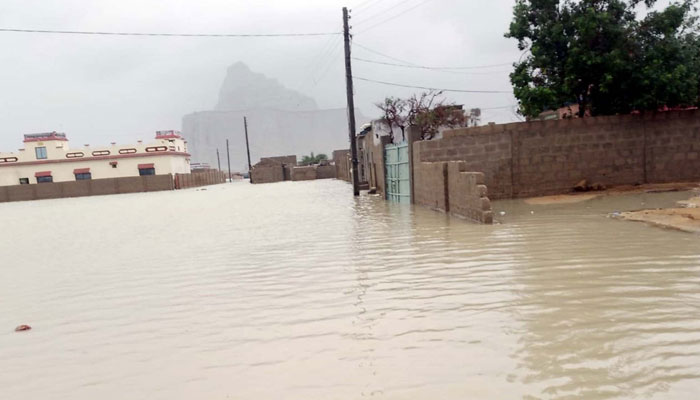When it rains it floods
In Jiwani, also within Gwadar district, heavy rains broke three dams and collapsed boundary walls and roofs of several houses
Rain and floods are old companions in Pakistan, with the latter almost always following the former. Starting from late Monday night (February 26) Gwadar, along with other areas in Balochistan, began receiving a lot of rain, around 183mm in over 24 hours to be precise. This was reportedly the heaviest rain spell in Gwadar since 2010 and the Pakistan Meteorological Department’s (PDM) chief meteorologist has said that such intense rain is unusual in this part of Pakistan during this time of year. The city’s district administration has declared a state of emergency as the rainwater entered homes and shops and the roads were inundated by knee-deep water, bringing life to a standstill. In Jiwani, also within Gwadar district, the heavy rains broke three dams and collapsed the boundary walls and roofs of several houses. While rescue and relief efforts are underway, this is yet another sign of how woeful our urban infrastructure is and the importance of building climate-resilient infrastructure in the face of increasingly erratic and extreme weather patterns due to global warming.
Rain is both something that Pakistan seemingly cannot live with or without. With agriculture being the lynchpin of our economy, accounting for around a quarter of our GDP as per the statistics bureau, a steady supply of seasonal rain is essential for healthy crops and also to replenish our increasingly strained water tables. The country has been ranked 14th out of the 17 ‘extremely high water risk’ countries of the world, with over 80 per cent of the population facing severe water scarcity for at least one month of the year. Strangely enough, in December 2023, the concern was too little rain with the PMD reportedly saying that Pakistan only had 90 per cent of its average rainfall in December and highlighted the increasing frequency of extreme swings in weather patterns from drought-like conditions to excessive precipitation.
Climate resilient-infrastructure and food and farming systems will be essential to cope with such swings. Although the IMF has been nudging the state in this direction, with building climate resilience one of the requirements of the $3 billion Standby Arrangement with the multilateral lender, our climate policy, like most of our policies, is perhaps still too centralized. Gwadar is not Islamabad or Karachi, and climate-resilience policies ought to be tailored to meet the unique local requirements that come with a country as diverse as Pakistan. More localized policy is also better able to balance the needs of local communities with broader objectives. There is also the imperative of raising the revenues needed for climate finance. Between 2002 and 2020 Pakistan only managed to mobilize around $2.8 billion for climate finance and it will need around $348 billion by 2030 to achieve systemic resilience, according to the World Bank. It would be grossly unfair to ask a poor country struggling to keep its economy afloat to come up with all this money on its own. In fact, given that it is the rich countries most responsible for the erratic weather patterns we are seeing today, one can argue that it is they who should foot this bill.
-
 The Truth Behind Victoria Beckham's 'inappropriate' Wedding Dance Video
The Truth Behind Victoria Beckham's 'inappropriate' Wedding Dance Video -
 AI Startup Raises $480 Million At $4.5 Billion Valuation In Earlier Gains
AI Startup Raises $480 Million At $4.5 Billion Valuation In Earlier Gains -
 North Carolina Woman Accused Of Serving Victims With Poisoned Drinks
North Carolina Woman Accused Of Serving Victims With Poisoned Drinks -
 Robert Redford’s Daughter Amy Sings Praises Of Late Father
Robert Redford’s Daughter Amy Sings Praises Of Late Father -
 OpenAI And ServiceNow Team Up To Embed ChatGPT In Business Workflows
OpenAI And ServiceNow Team Up To Embed ChatGPT In Business Workflows -
 Johnny Depp Prepares For His Massive Comeback After Years Of Struggle
Johnny Depp Prepares For His Massive Comeback After Years Of Struggle -
 Meghan Markle Is Ready To Put A Cork In It All By Giving Prince Harry Baby No. 3: ‘She Wants A Break’
Meghan Markle Is Ready To Put A Cork In It All By Giving Prince Harry Baby No. 3: ‘She Wants A Break’ -
 Billie Eilish Speaks Out Against Authority: 'It's Very Strange'
Billie Eilish Speaks Out Against Authority: 'It's Very Strange' -
 'Greenland Will Stay Greenland', Former Trump Adviser Hints At New Twist
'Greenland Will Stay Greenland', Former Trump Adviser Hints At New Twist -
 Brooklyn Beckham's Wedding Dance With Mom Victoria Sparks Hilarious Memes
Brooklyn Beckham's Wedding Dance With Mom Victoria Sparks Hilarious Memes -
 King Charles' Latest Photos A Statement On His Health?
King Charles' Latest Photos A Statement On His Health? -
 Tom Cruise's Biggest Dream Crushed By The President?
Tom Cruise's Biggest Dream Crushed By The President? -
 King Charles, Queen Camilla Send Message To King Of Spain After Train Crash
King Charles, Queen Camilla Send Message To King Of Spain After Train Crash -
 'We Believe Brooklyn': David Beckham Trolled After Son's Statement
'We Believe Brooklyn': David Beckham Trolled After Son's Statement -
 Microsoft CEO Says AI Must Deliver Real World Impact To Survive
Microsoft CEO Says AI Must Deliver Real World Impact To Survive -
 Stranger Knocks, Then Opens Fire On Indiana Judge And Wife
Stranger Knocks, Then Opens Fire On Indiana Judge And Wife




